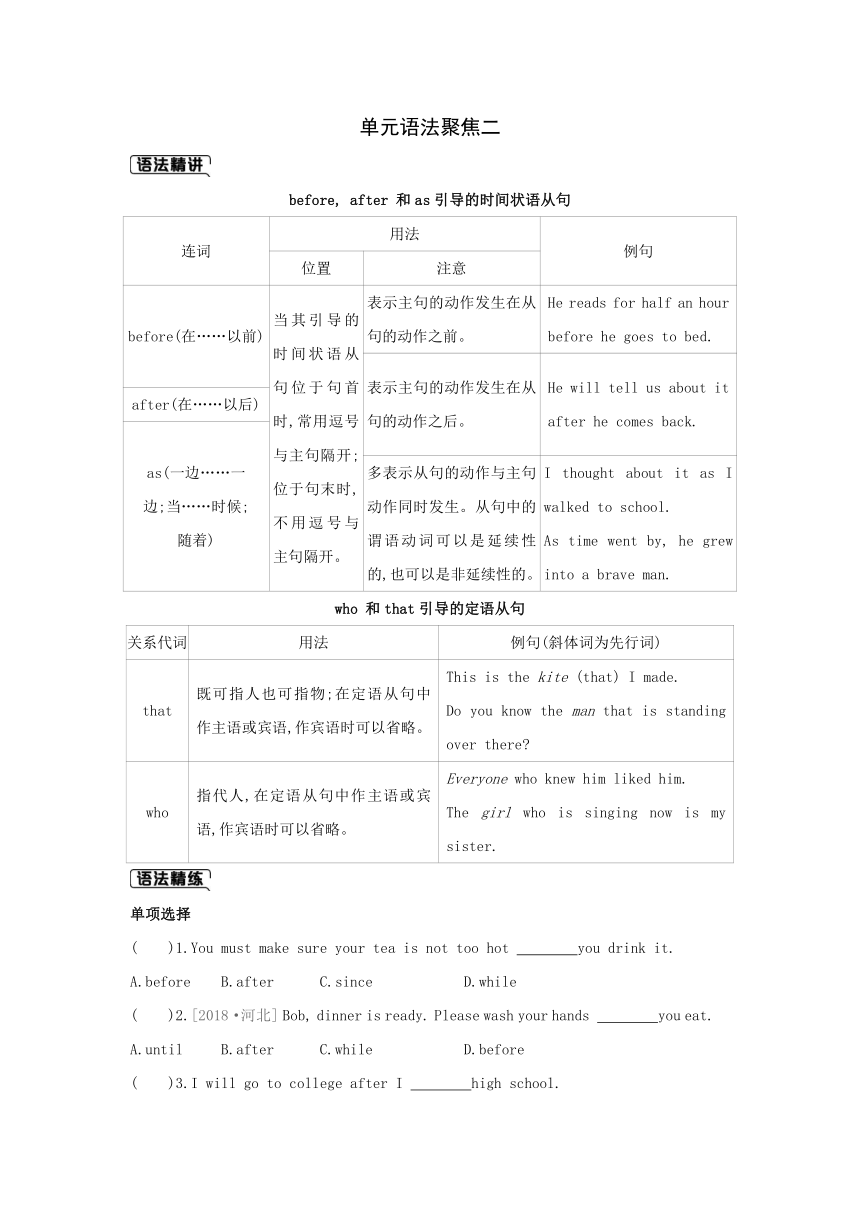冀教版九年级上册Unit 2Great People单元语法聚焦(Word版,含答案)
文档属性
| 名称 | 冀教版九年级上册Unit 2Great People单元语法聚焦(Word版,含答案) |  | |
| 格式 | docx | ||
| 文件大小 | 53.1KB | ||
| 资源类型 | 教案 | ||
| 版本资源 | 冀教版 | ||
| 科目 | 英语 | ||
| 更新时间 | 2022-06-20 16:35:02 | ||
图片预览

文档简介
单元语法聚焦二
before, after 和as引导的时间状语从句
连词 用法 例句
位置 注意
before(在……以前) 当其引导的时间状语从句位于句首时,常用逗号与主句隔开;位于句末时,不用逗号与主句隔开。 表示主句的动作发生在从句的动作之前。 He reads for half an hour before he goes to bed.
表示主句的动作发生在从句的动作之后。 He will tell us about it after he comes back.
after(在……以后)
as(一边……一 边;当……时候; 随着)
多表示从句的动作与主句动作同时发生。从句中的谓语动词可以是延续性的,也可以是非延续性的。 I thought about it as I walked to school. As time went by, he grew into a brave man.
who 和that引导的定语从句
关系代词 用法 例句(斜体词为先行词)
that 既可指人也可指物;在定语从句中作主语或宾语,作宾语时可以省略。 This is the kite (that) I made. Do you know the man that is standing over there
who 指代人,在定语从句中作主语或宾语,作宾语时可以省略。 Everyone who knew him liked him. The girl who is singing now is my sister.
单项选择
( )1.You must make sure your tea is not too hot you drink it.
A.before B.after C.since D.while
( )2.[2018·河北] Bob, dinner is ready. Please wash your hands you eat.
A.until B.after C.while D.before
( )3.I will go to college after I high school.
A.finish B.finished C.is finishing D.will finish
( )4.[2020·温州] Little Mary says good night to her parents she goes to bed every day.
A.if B.until C.before D.unless
( )5. the years went by, these buildings became older and older.
A.Before B.After C.As D.Until
( )6.[2019·大庆] The book I read last night was fantastic.
A.that B.what C.whose D.who
( )7.[2019·随州] —What kind of movies do you like
—I prefer movies give me something to think about.
A.which B.who C.what D.when
( )8.[2020·黄冈] —Do you know the girl is giving the speech
—Of course. She is my best friend, Meimei.
A.which B.who C.whom D.what
( )9.[2020·贵阳改编] In difficult times, there are always national heroes step up and bring people hope.
A.whom B.which C.who D.whose
( )10.[2018·无锡] He stayed up very late that night. he woke up in the morning, the sun was already high up in the sky.
Until B.After C.While D.As
答案
单元语法聚焦二
1.A 连词辨析。句意:在喝之前,你必须确保你的茶不太烫。 before意为“在……之前”;after意为“在……之后”;since意为“自从;既然;因为”;while意为“当……时;然而”。根据语境可知,应该在喝之前判断茶是不是太烫。故选A。
2.D 3.A 4.C 5.C 6.A 7.A 8.B 9.C
10.D 连词辨析。句意:那天晚上他熬夜到很晚。当他早上醒来的时候,太阳已经升得很高了。在while引导的时间状语从句中,动词应用延续性动词;表示两个同步发展的动作和行为时,应用as,表示“当……时”。故选D。
before, after 和as引导的时间状语从句
连词 用法 例句
位置 注意
before(在……以前) 当其引导的时间状语从句位于句首时,常用逗号与主句隔开;位于句末时,不用逗号与主句隔开。 表示主句的动作发生在从句的动作之前。 He reads for half an hour before he goes to bed.
表示主句的动作发生在从句的动作之后。 He will tell us about it after he comes back.
after(在……以后)
as(一边……一 边;当……时候; 随着)
多表示从句的动作与主句动作同时发生。从句中的谓语动词可以是延续性的,也可以是非延续性的。 I thought about it as I walked to school. As time went by, he grew into a brave man.
who 和that引导的定语从句
关系代词 用法 例句(斜体词为先行词)
that 既可指人也可指物;在定语从句中作主语或宾语,作宾语时可以省略。 This is the kite (that) I made. Do you know the man that is standing over there
who 指代人,在定语从句中作主语或宾语,作宾语时可以省略。 Everyone who knew him liked him. The girl who is singing now is my sister.
单项选择
( )1.You must make sure your tea is not too hot you drink it.
A.before B.after C.since D.while
( )2.[2018·河北] Bob, dinner is ready. Please wash your hands you eat.
A.until B.after C.while D.before
( )3.I will go to college after I high school.
A.finish B.finished C.is finishing D.will finish
( )4.[2020·温州] Little Mary says good night to her parents she goes to bed every day.
A.if B.until C.before D.unless
( )5. the years went by, these buildings became older and older.
A.Before B.After C.As D.Until
( )6.[2019·大庆] The book I read last night was fantastic.
A.that B.what C.whose D.who
( )7.[2019·随州] —What kind of movies do you like
—I prefer movies give me something to think about.
A.which B.who C.what D.when
( )8.[2020·黄冈] —Do you know the girl is giving the speech
—Of course. She is my best friend, Meimei.
A.which B.who C.whom D.what
( )9.[2020·贵阳改编] In difficult times, there are always national heroes step up and bring people hope.
A.whom B.which C.who D.whose
( )10.[2018·无锡] He stayed up very late that night. he woke up in the morning, the sun was already high up in the sky.
Until B.After C.While D.As
答案
单元语法聚焦二
1.A 连词辨析。句意:在喝之前,你必须确保你的茶不太烫。 before意为“在……之前”;after意为“在……之后”;since意为“自从;既然;因为”;while意为“当……时;然而”。根据语境可知,应该在喝之前判断茶是不是太烫。故选A。
2.D 3.A 4.C 5.C 6.A 7.A 8.B 9.C
10.D 连词辨析。句意:那天晚上他熬夜到很晚。当他早上醒来的时候,太阳已经升得很高了。在while引导的时间状语从句中,动词应用延续性动词;表示两个同步发展的动作和行为时,应用as,表示“当……时”。故选D。
同课章节目录
- Unit 1 Stay Healthy
- Lesson 1 What's Wrong,Danny?
- Lesson 2 A Visit to the Dentist
- Lesson 3 Good Food, Good Health
- Lesson 4 Don't Smoke, Please!
- Lesson 5 Jane's Lucky Life
- Lesson 6 Stay Away from the Hospital
- Unit Review
- Unit 2 Great People
- Lesson 7 What Is the Meaning of Lift?
- Lesson 8 A Universe of Thought
- Lesson 9 China's Most Famous "Farmer"
- Lesson 10 Touch the World
- Lesson 11 To China, with Love
- Lesson 12 Guess My Hero!
- Unit Review
- Unit 3 Safety
- Lesson 13 Be Careful,Danny!
- Lesson 14 Accidents Happen
- Lesson 15 My Helmet Saved My Life!
- Lesson 16 How Safe Is Your Home?
- Lesson 17 Staying Safe in an Earthquake
- Lesson 18 Never Catch a Dinosaur
- Unit Review
- Unit 4 Stories and poems
- Lesson 19 A Story or a Poem?
- Lesson 20 Say It in Five
- Lesson 21 The Fable of the Woodcutte
- Lesson 22 The Giant(Ⅰ)
- Lesson 23 The Giant(Ⅱ)
- Lesson 24 Writing a Poem
- Unit Review
- Unit 5 Look into Science
- Lesson 25 Let's Do an Experiment!
- Lesson 26 Keep the Candle Burning
- Lesson 27 Planet Danny
- Lesson 28 The Study of Living Things
- Lesson 29 DNA—The Story of You
- Lesson 30 Science Affects Us
- Unit Review
- Unit 6 Movies and Theate
- Lesson 31 A movie or a Play
- Lesson 32 Moving Pictures
- Lesson 33 The Fisherman and the Goldfish(Ⅰ)
- Lesson 34 The Fisherman and the Goldfish(Ⅱ)
- Lesson 35 Theatres Are Fun!
- Lesson 36 Making Plays Is Fun
- Unit Review
